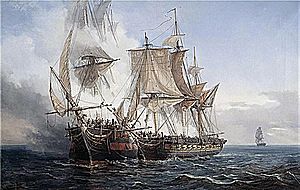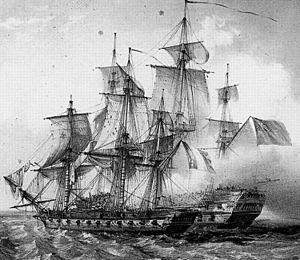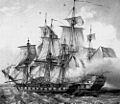Lord Nelson (East Indiaman) facts for kids
The Lord Nelson was a large sailing ship, called an East Indiaman. It was built in 1799 for the East India Company, a big British trading company. This ship made five long trips, but only finished four of them.
On its second trip, a French privateer ship named Bellone captured it. But don't worry, the Royal Navy got it back quickly! Sadly, on its fifth trip in 1808, the Lord Nelson disappeared in a storm, and everyone on board was lost.
Contents
The Ship's First Journey (1800–1801)
The Lord Nelson began its first voyage under Captain Robert Spottiswoode. He had sailed for the East India Company many times before. This was his first time as a captain.
The ship left on March 17, 1800. It sailed to places like Madras in India and Whampoa anchorage in China. After a long journey, it returned to Britain on June 17, 1801.
The Ship's Second Journey (1802)
Captain Robert Spottiswoode was still in command for the second voyage. The Lord Nelson left Britain on March 14, 1802. It was heading to India and the Bay of Bengal.
Captured by a Privateer
On its way back home, on August 14, 1803, the Lord Nelson met a French ship called Bellone. This was off the coast of Ireland. The Bellone was a privateer, which was like a private warship. It was allowed by its government to attack enemy ships.
The Bellone had 34 guns, while the Lord Nelson had 32. But the biggest difference was the crew size. The Bellone had 260 sailors, while the Lord Nelson had only 102.
The two ships fought for about an hour and a half. The Lord Nelson tried to stop the French from boarding. But the Bellone eventually managed to get its crew onto the Lord Nelson. During the fight, five of the Lord Nelson's crew and passengers were killed. Thirty-one more were hurt.
The French captain put 41 of his men on the Lord Nelson. They planned to sail it to a Spanish port.
Getting the Ship Back
A British ship called Seagull, led by Captain Henry Burke, heard about the French privateer. Captain Burke decided to find the Bellone.
On August 26, he saw a large ship and chased it for five hours. It turned out to be the Lord Nelson, now controlled by the French. They fought all night. The Lord Nelson was running out of ammunition. The French captain was about to give up.
But Captain Burke had to stop fighting to fix his ship. While he was doing repairs, a group of British warships appeared. These ships were led by Sir Edward Pellew. When the French saw the new British ships, they surrendered the Lord Nelson.
The Seagull had two men killed and eight wounded in the fight. The Lord Nelson was then escorted back to Britain. The East India Company rewarded Captain Spottiswoode for bravely defending his ship.
A Story in a Book
The exciting story of the Lord Nelson's capture and recapture is even in a book! It's part of Chapter 5 of Patrick O'Brian's novel Post Captain. In the book, fictional characters like Captain Jack Aubrey are passengers on the Lord Nelson during this event.
The Ship's Third Journey (1804–1805)
For its third trip, the Lord Nelson had a new captain, Wemyss Orrok. The ship now carried 32 guns.
It left Britain on March 20, 1804. It sailed with a group of eight other East Indiamen ships. A British warship, HMS Lapwing, protected them.
The Lord Nelson visited places like Madras and Diamond Harbour in India. It returned to Britain on September 12, 1805. Sadly, Captain Orrok died during the return journey. His first officer, Frederick Gaillard, likely took command.
The Ship's Fourth Journey (1806–1807)
Captain William Charles Hutton took command for the fourth voyage. The Lord Nelson still had 32 guns.
It left Britain on March 30, 1806. It traveled with other East Indiamen ships. They were protected by HMS Leopard.
During this trip, another ship in the convoy, the Lady Burges, crashed on a reef. Many people were rescued, but 34 drowned.
The Lord Nelson visited the Cape of Good Hope in Africa, and then Diamond Harbour, Madras, and Bombay in India. It returned to Britain on September 6, 1807.
The Ship's Final Journey (1808)
Captain William Charles Hutton was still the captain for the fifth and final voyage. The Lord Nelson left Britain on March 5, 1808. It was heading to Madras and Bengal in India.
Forced Sailors
When the Lord Nelson arrived in Madras, a British admiral named Pellew was there. He needed more sailors for his warships. He used a practice called impressment. This meant he forced 157 men from the trading ships, including the Lord Nelson, to join the navy.
The captains were very angry. They said they didn't have enough men to sail their ships safely. Admiral Pellew gave back 24 men. Captain Hutton and the others had to hire local sailors, called lascars, to make up their crew numbers.
Lost at Sea
On October 26, 1808, the group of ships left Madras. Captain Hutton was the leader of the group. Around November 20, a big storm began. The storm scattered all the ships.
The Lord Nelson lost contact with the other ships on November 21. It was never seen or heard from again. Two other East Indiamen ships, the Experiment and the Glory, also disappeared in the same storm. Everyone on board the Lord Nelson was lost.
Images for kids





